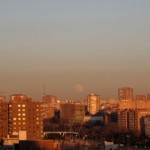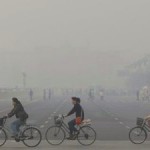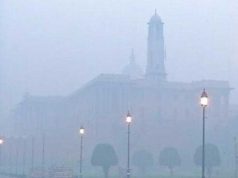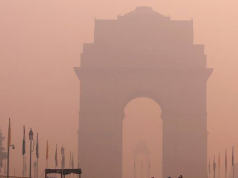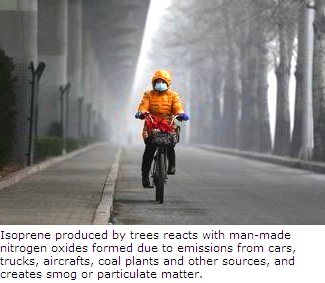 Source: University of North Carolina at Chapel Hill
Source: University of North Carolina at Chapel Hill
Authors: Ying-Hsuan Lin, et al.
Topic Area: Trees, Emissions, Air Pollution
Geographic Area: Global
After years of scientific uncertainty and speculation, researchers at the University of North Carolina at Chapel Hill show exactly how trees help create one of society’s predominant environmental and health concerns: air pollution.
It has long been known that trees produce and emit isoprene – an abundant molecule in the air known to protect leaves from oxygen damage and temperature fluctuations. However, in 2004, researchers, contrary to popular assumptions, revealed that isoprene was likely involved in the production of particulate matter, tiny particles that can get lodged in lungs, lead to lung cancer and asthma, and damage other tissues, not to mention the environment.
But exactly how was anybody’s guess.
Jason Surratt, Assistant Professor of Environmental Sciences and Engineering at the Gillings School of Global Public Health, now reveals one mechanism by which isoprene contributes to the production of these tiny, potentially health-damaging particles.
The study found that isoprene, once it is chemically altered via exposure to the sun, reacts with man-made nitrogen oxides to create particulate matter. Nitrogen oxides are pollutants created by cars, trucks, aircrafts, coal plants and other large scale sources.
“The work presents a dramatic new wrinkle in the arguments for reducing man-made pollutants worldwide,” said Surratt, whose work was published in April in the Proceedings of the National Academy of Sciences. “Isoprene evolved to protect trees and plants, but because of the presence of nitrogen oxides, it is involved in producing this negative effect on health and the environment.”
“We certainly can’t cut down all the trees,” Surratt adds, “but we can work on reducing these man-made emissions to cut down the production of fine particulate matter.”
With the precise mechanism now revealed, researchers can plug it into air quality models for better predicting episodes of air pollution and potential effects on earth’s climate. The advance would allow researchers and environmental agencies to evaluate and make regulatory decisions that impact public health and climate change.
“We observe nature’s quirks, but we must always consider that our actions do have repercussions,” said Surratt. “It’s the interaction between these natural and man-made emissions that produces this air pollution, smog and fine particulate matter – and now we know one reason for how it happens.”
Source: The University of North Carolina at Chapel Hill, North Carolina.






